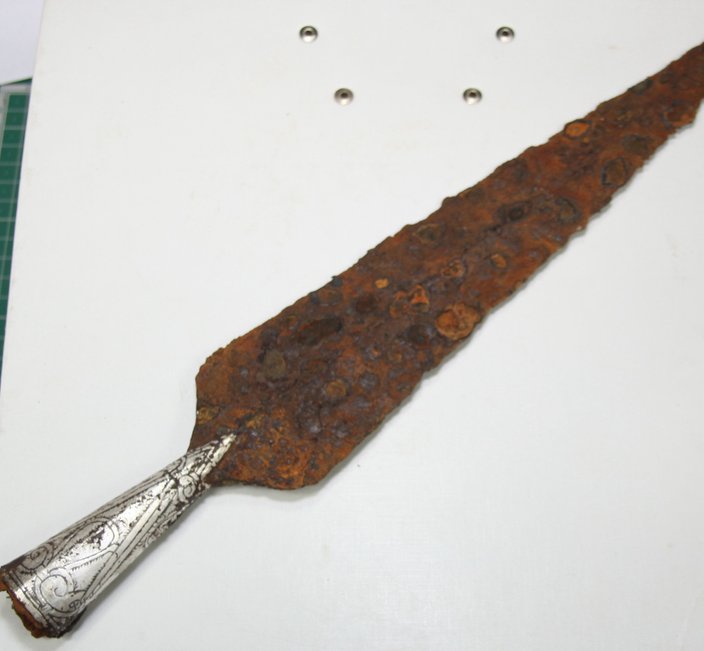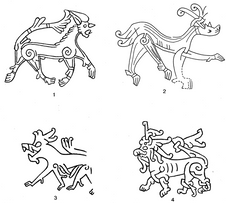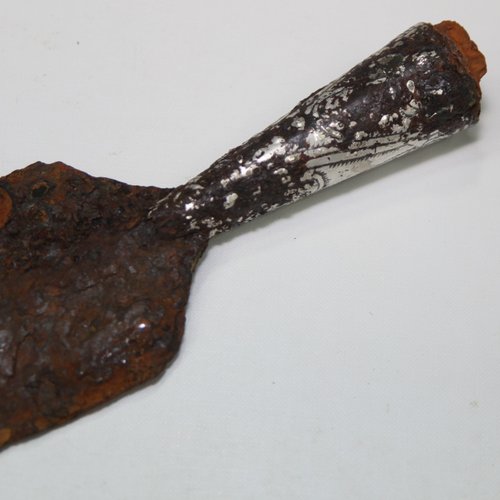Well. I could have been with these stones until after dark, but as my wife wanted to travel on.. well.. I see you again, some day, hogback stones from Gosforth. And if you happen to be there one day, do not forget that monument on the outside...
Further on with the Cumbrian hogbacktour !
In - yes, luckily again in - St. Peter's church in Heysham, there is a truly beautiful hogback stone. The guide told us, it had been studyied by Thor Ewing, a writer, in 2000. in 'Understanding the Heysham hogback' A tenth century sculpted stone monument and its context (link), Thor Ewing tells in detail what he dicovered on the both sides of this hogback stone.
Just being brought in the church as late as the 1970's accompanied with some protest here and there among the church visitors, considered as being a token of old paganism, it had been remarkably nice preserved, and a lot of detail can be seen, still. Truly worthwile a visit.
I had a small debate with the guide in the church if the - zoomorphic, in my opinion - faces on the sides were lions (or hippo's). The guide doubted if the vikings could have known about lions. Well I guess so, concerning the runes on the Ancient Greek lion statue at the Arsenal, Venice. For example. Vikings did travel south..
But when he told me he was doubting the vikings 'discovered' (as the native inhabitants were of course, in the first place) America before Columbus, I decided to rest my case..
One has to know when to start and to end a conversation ..
Just discovered the book in a bookstore written by Geoff Holder - The guide to the mysterious Lake District, I knew there had to be another hogback stone in Lowther, St. Micheal's Church. With a promising image described in the text of 'a naval and a land-based force of shield-bearing vikings above a fish and what might be a coiled sea serpent. On the reverse is a row of female figures with snakes, possibly a representation of the hideous hag Hel'. Wow. If that did not sound as a true pagan promised land ..
Not complaing too much after all we have seen, this visit was the dissapointing one of them all. But if you wife states 'I am happy to have seen them' and I am answering 'Measuring is knowing' and the even more obligate verb 'handling 'if we did not see it at all, we wouldn't have known anything at all of how they were looking' the glass was again half full, at the last day of our journey..
The hogback stone appeared to be just being tolerated within the entrance segment part of the church. As something you never use anymore but you do not throw away - entirely. That sort of feeling emerged when seeing this hogback asylum seekers.. Bed, bath and bread, ás we say in Dutch, but no luxury at all and standing on some outcuts of wood, you would balance the table with at home..
Come on, St. Micheal's Church.. care a bit more of your 'children' !
This hogback stone was moved in the church in 1907. Hogback stones layed partially buried in the churchyard before it was dug up and moved into the church.
The promising depiction of a longship - as certainly can be seen after some studying - see http://vikingminds.co.uk/pages/longship
we have missed !
The stone itself is (157 x 50 x 30 cm) and very worn.
The hogback stones in Cumbria - very diverse in quality, but everyone worth a visit ! Especially on a gloomy day in late October ...
The churches to visit - see photos of resp. St. Andrew's church in Penrith, St. Mary's church in Gosforth, St. Peter's church in Heysham and St. Micheal's church in Lowther.
Did I miss out on another one in Cumbria ? Let me know !
In a next blog I will take you to four - still remaining utterly mysterious- statues 'guarding' the graveyard of St. Andrew's church in Dacre..
For the last blog of October 9th see this link.
<script>
(function(i,s,o,g,r,a,m){i['GoogleAnalyticsObject']=r;i[r]=i[r]||function(){
(i[r].q=i[r].q||[]).push(arguments)},i[r].l=1*new Date();a=s.createElement(o),
m=s.getElementsByTagName(o)[0];a.async=1;a.src=g;m.parentNode.insertBefore(a,m)
})(window,document,'script','//www.google-analytics.com/analytics.js','ga');
ga('create', 'UA-56164482-1', 'auto');
ga('send', 'pageview');
</script>
December 29th 2014 -
A Scandinavian Viking type spearhead with silver covered socket in Ringerike style
This week I like to show you a Viking Age spear head of Scandinavian type. These distinct type of spear head is very attractive looking because of its silver covering and decoration of the socket. I will also tell something about the specific art style, the Ringerike style, wich with this silver is decorated in.
Why specific Scandinavian ?
More than 60 Late Viking-Age spearheads found in Finland have silver ornamented sockets, the majority of which are ‘decorated with runic animals’ (in the Swedish ‘Runestone’ style). At least seven different animal forms of Urnes-style type are distinguished, with parallels on Gotland.
Surveys a group of Viking-Age silver-ornamented spearheads (late ninth/ early tenth-century to eleventh century) found in Estonia, Latvia and Finland. Concludes that, although the majority were imported from Scandinavia, there may have been some attempts at local manufacture, following Scandinavian models, towards the end of the Viking Age.
Another example of a find is centred around a rich blacksmith’s grave at By in Hedmark, is of late Viking Age origin, mainly 11th century (Martens 969; 2002). Here the sockets of the M-type spearheads are decorated in Ringerike style, which
makes it very likely that they were made in the Nordic countries (Fuglesang 1980:42).
Ringerike Style
The socket decoration on the spear head is of Ringerike style of pattern type B.
The Ringerike Style and the Urnes Style are the two art-styles that flourished consecutively during the 11th century in Scandinavia - until the end of the Viking Age, with the introduction of the European Romanesque - may be considered to encapsulate much of the essence of the Viking Age itself. Main characteristics in Ringerike Style decoration is the foliate motif, the use of intertwining tendrils, combined with alternating lobs and tendrils. A common feature within the decoration is the form of a spiral in the hip of a so called 'Great Beast' (see also the Ringerike style sword strap devider in The Artefacts section).
This distinct use of a spiral curl can be seen on the lower part of the silver decoration on the socket, as well as on top of it.
The Ringerike Style was fashionable in Scandinavia during the period between about 990 and 1050, by wich time it was already in transition to become the Urnes Style.
Image of characteristic spiral hip decoration within the Ringerike Style ornamentation.
Background information and reference:
James Graham-Campbell, Viking Art, 2013, p. 116 - 133
I would also like to express my thanks to him, giving me some very fine references on this subject (the underlined references are clickable as links to the reference text).
See p. 133 Fig. 7 Socket decorations on spearheads: Blindheim’s pattern types Aa, Ab, and B (Ringerike Style)
See p. 216 Fig. 2 Some ornaments in the Ringerike style on the sockets of Estonian spearheads
See image p. 123 Fig. 1. Ringerike style patterns on spearhead sockets.
Image beneath: (I will address the reference later, as I just found this image on someone's Pinterest page)
Spears and javelins from the Viking Age - type 6: addressed here as 'a typical pattern'.
Also see: Vikings; Life and legend (2013) The British Museum (catalogue accompanying the exhibition held in several national musea in Europe during 2013 and 2014), p. 106, spearhead with silver-inlaid socket, 11th century from Vilusenharju, Tampere, Upper Satakunta, Finland.
Similar style silver decorated spear heads images can also be seen clicking at this link.
The artefacts....
On the subpages above, I will show a digital museum tour alongside my viking artefacts. Besides a detailled describtion, I will place them in their context of how they were used in every day viking life en add references to books where they are published in (or a similarlike example),literature, publications or studies when appropiate.
When I have questions about a type of artefact, I will mention so, and invite everyone to share his opinion.
The joy of collecting artefacts is holding an item + 1000 years old and be able to touch a mystery...
Who made it and for who ? How would the person have looked like who casted it.. ? Who buyed or received it and when ? Who whore it and what did other vikings think of the person who used the item.. where was it made/found (often not known precise). What is the meaning of some decorations on a piece ( we often do not know)..
And not the last.. what would the person to where it belonged to, would think of an middle aged man in Holland, holding it in his hands that 1000+ years later and wondering about al these mysteries... ?
References: (as always, links to where the books can be ordered are attached).
Edwards, B.J.N. Vikings in North West England - The artifacts (1998);
Emery, Gordon, CURIOUS CUMBRIA, The Lake District & Beyond: A celebration of Cumbria (2023)
Ewing, T. 'Understanding the Heysham hogback' A tenth century sculpted stone monument and its context ;
Hall, R. Viking Age archaeology in Britain and Ireland (first printed 1990, reprinted with amendments in 1995);
Holder, G. The guide to the mysterious Lake District (2009)
possibly also (as there within the part of Cumbria dealing with Carlisle, the Eden Valley, Barrow-in-Furness, Whitehaven and the west coast is being dealed with)
Holder, G. Paranormal Cumbria (2010)
http://vikingminds.co.uk/pages/longship


